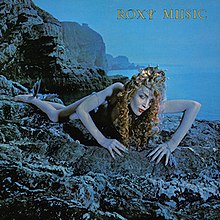|
Siren (Roxy Music album)
Siren is the fifth studio album by the English rock band Roxy Music, released in 1975 by Island Records. It was released by Atco Records in the United States.[1] Siren produced the singles "Love Is the Drug" and "Both Ends Burning", which peaked at numbers two and 25 respectively on the UK Singles Chart. "Love Is the Drug" became Roxy Music's highest-charting single in the US, reaching number 30 on the Billboard Hot 100.[2] In 2003, Siren was ranked number 371 on Rolling Stone magazine's list of the 500 Greatest Albums of All Time. Cover artThe cover features band member Bryan Ferry's then-girlfriend, model Jerry Hall, on rocks near South Stack, Anglesey. Graham Hughes, working during August 1975, took the cover photo directly below the central span of the bridge on a south-side slope. He worked from sketches produced by Antony Price, with photography featuring Hall striking various poses. The idea for the location was Bryan Ferry's, after he saw a TV documentary about lava flows and rock formations in Anglesey, in which South Stack was heavily featured. Critical reception
In a contemporary review of Siren for Melody Maker, critic Allan Jones praised it as "a superb album, striking the listener immediately with a force and invention reserved only for the most special musical experiences".[9] He noted a "crispness and vitality" in Chris Thomas's production, which he felt showcased "the sense of adventure and cavalier spirit which marked their early recordings, an impetuosity which has lately been absent from their work."[9] Rolling Stone writer Simon Frith highlighted the album's more "focused" lyrical imagery and streamlined production, noting "less synthesized clutter, fewer sound effects, more straight solo trading."[10] Robert Christgau of The Village Voice found the album's more pop-leaning sound to be revelatory: "Of course, Roxy Music albums have always had hooks, but 'Street Life' and 'Virginia Plain' never told us as much about Roxy's less accessible music as 'Love Is the Drug'".[8] He ranked it the 11th best album of 1975 in his year-end "Dean's List".[11] Siren placed at number 13 on The Village Voice's 1975 Pazz & Jop critics' poll.[12] Critic Greil Marcus included Siren in the appendix of his 1979 book Stranded: Rock and Roll for a Desert Island, with the following accompanying write-up: "Don Juan Faces Life: With the band hitting the limits of the music that grew from Rubber Soul, Ferry dismantled his lounge lizard act bit by bit, until all that was left was what his entire career had meant to hide: 'an average man', but one with enough emotion to record for Motown."[13] LegacySiren remains one of Roxy Music's most critically acclaimed albums. Critic Dave Marsh described Siren in 1983 as "Roxy's masterpiece, calling the listener back by virtue of its finely honed instrumental attack and compelling lyrical attitude".[14] In a retrospective review for AllMusic, Stephen Thomas Erlewine wrote that Roxy Music's unabashed embrace of dance and pop music on Siren, while resulting in their distinctive "artier tendencies" being toned down, produces "a thematic consistency that works in [the album's] favor" and elevates it "into the realm of classics".[3] Rob Sheffield refers to Siren as "the first Roxy Music album without any failed moments" in 2004's The New Rolling Stone Album Guide.[6] Simon Reynolds was less receptive in a 1999 article for Uncut. He acknowledged that Siren continued to be "universally" held in high regard, particularly by American critics, but considered it and its predecessor Country Life to be "conventional and tame" compared to the band's earlier output.[15] Rolling Stone ranked Siren at number 371 on its 2003 list of the 500 greatest albums of all time,[16] and at number 374 on a 2012 version of the list.[17] Vibe included it in its list of the 100 essential albums of the 20th century, describing it as a fusion of "the esoteric murk of early Roxy" and "the aching, ardently romantic tone that defines their later work".[18] Track listingAll tracks are written by Bryan Ferry, except where noted
On cassette tapes (e.g. Island ZC19344) "Whirlwind" and "Just Another High" (the last track of each side) are swapped, presumably for optimum tape length. PersonnelRoxy Music
Production
Charts
Certifications
References
Further reading
|
||||||||||||||||||||||||||||||||||||||||||||||||||||||||||||||||||||||||||||||||||||||||||||||||||||||||||||||||||||||||||||||||||
